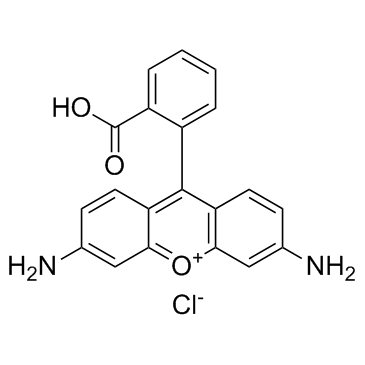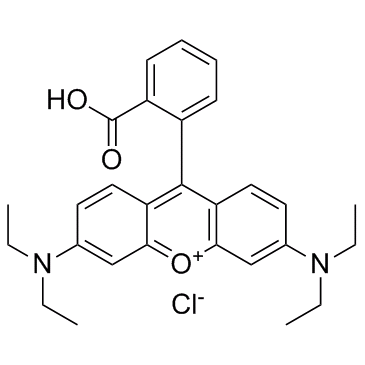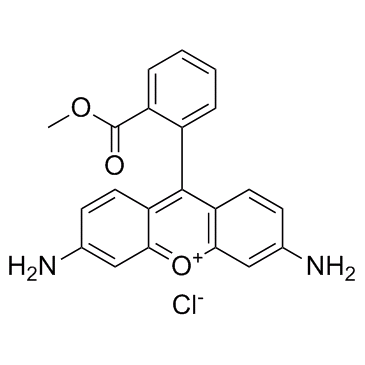13558-31-1
| Name | rhodamine 110 |
|---|---|
| Synonyms |
2-(3-amino-6-iminoxanthen-9-yl)benzoic acid,hydrochloride
Benzoic acid, 2-(6-amino-3-imino-3H-xanthen-9-yl)-, hydrochloride (1:1) Rhodamine 110 2-(6-Amino-3-imino-3H-xanthen-9-yl)benzoic acid hydrochloride Rhodamine 110,laser grade Rhodamine 110 chloride MFCD00042009 2-(6-Amino-3-imino-3H-xanthen-9-yl)benzoic acid hydrochloride (1:1) EINECS 236-944-7 |
| Description | Rhodamine 110 is a xanthene dye similar to fluorescein and eosin. |
|---|---|
| Related Catalog | |
| In Vitro | Rhodamine 110 accumulates in mitochondria in a cationic form, which alters the pH in this cellular compartment. Rhodamine 110 accumulates in human lymphoblastoid cells and Friend leukemia cells. No cytotoxicity to human lymphoblastoid cells is observed below 10 μM, but Rhodamine 110 causes Friend leukemia cells to die at a concentrations above 100 μM[1]. |
| In Vivo | Rhodamine 110 is less toxic than the parent molecule based on the intravenous LD50 acute toxicity values of 89.5 mg/kg and 140.0 mg/kg for Rhodamine B and Rhodamine 110, respectively. Both molecules induce liver and kidney enlargement after ingestion, and male rats show more significant increases than female rats after Rhodamine 110 exposure. In addition, testis weight increased in male rats dosed with Rhodamine 110. The pharmacokinetics of Rhodamine 110 are assessed following oral administration at two dosages (3 and 10 mg/kg) and intravenous administration at one dosage (3 mg/kg). Pharmacokinetic parameters are calculated using an extravascular input and IV-bolus input, noncompartmental model analysis conducted with WinNonlin Standard Edition. The pharmacokinetic parameters of Rhodamine 110 indicates that the maximum plasma concentrations (Cmax) of the two oral dosages are 283.4 and 657.0 ng/mL, which are reached at 140 and 210 min, respectively. This indicates that Rhodamine 110 absorption is not rapid after ingestion, as it took over 2 h to be absorbed from the intestines into the blood. The areas under the concentration–time curves (AUCs) for the two dosages are 138.1±20.3 and 444.0±170.8 h ng/mL. The pharmacokinetic data demonstrate that the AUC is proportional to the administered oral dose of Rhodamine 110 (3 mg/kg and 10 mg/kg). Furthermore, the clearance (Cl) of the two orally administered doses is 7.94 and 8.61 mL/min/kg, respectively[1]. |
| Animal Admin | Rats[1] Adult male Sprague-Dawley rats (230±20 g) are used. After the rats recovered, Rhodamine 110 in polyethylene glycol 400 (0.3 and 1 mg/mL) is administered at 3 mg/kg and 10 mg/kg by oral gavage. Blood samples (150 μL) are collected from the right jugular vein 5, 15, 30, 60, 120, 180, 240, 300, 360, 480, and 720 min after drug administration. After each sampling, 100 μL of normal saline is administered via catheter to compensate for the loss of body fluid, and a 50 μL heparin solution (20 IU heparin/mL normal saline) is provided to prevent coagulation. Blood samples are centrifuged at 16,000g for 10 min at 4 °C to obtain plasma, which is stored at -20 °C until analysis. After surgery, Rhodamine 110 in polyethylene glycol 400 (1 mg/mL) is administered intravenously to rats at 3 mg/kg (n=6). A 150 μL blood sample is collected from the right jugular vein 5, 15, 30, 60, 120, 180, 240, 300, 360, 480, and 720 min after drug administration. Then, 100 μL of normal saline is administered via the right jugular vein to compensate for body fluid loss, and 50 μL of a heparin solution (20 IU heparin/mL normal saline) is provided to prevent blood clotting. |
| References |
| Boiling Point | 629.3ºC at 760 mmHg |
|---|---|
| Melting Point | >300 °C(lit.) |
| Molecular Formula | C20H15ClN2O3 |
| Molecular Weight | 366.798 |
| Flash Point | 334.4ºC |
| Exact Mass | 366.077118 |
| PSA | 100.31000 |
| LogP | 5.44740 |
| Vapour Pressure | 1.06E-16mmHg at 25°C |
| Personal Protective Equipment | Eyeshields;Gloves;type N95 (US);type P1 (EN143) respirator filter |
|---|---|
| Hazard Codes | Xn: Harmful; |
| Risk Phrases | R22 |
| Safety Phrases | 22-24/25 |
| RIDADR | NONH for all modes of transport |
| WGK Germany | 3 |
| HS Code | 2932999099 |
|
~% 
13558-31-1 |
| Literature: Journal of Physical Chemistry, , vol. 84, # 1 p. 51 - 55 |
| Precursor 1 | |
|---|---|
| DownStream 1 | |
| HS Code | 2932999099 |
|---|---|
| Summary | 2932999099. other heterocyclic compounds with oxygen hetero-atom(s) only. VAT:17.0%. Tax rebate rate:13.0%. . MFN tariff:6.5%. General tariff:20.0% |



